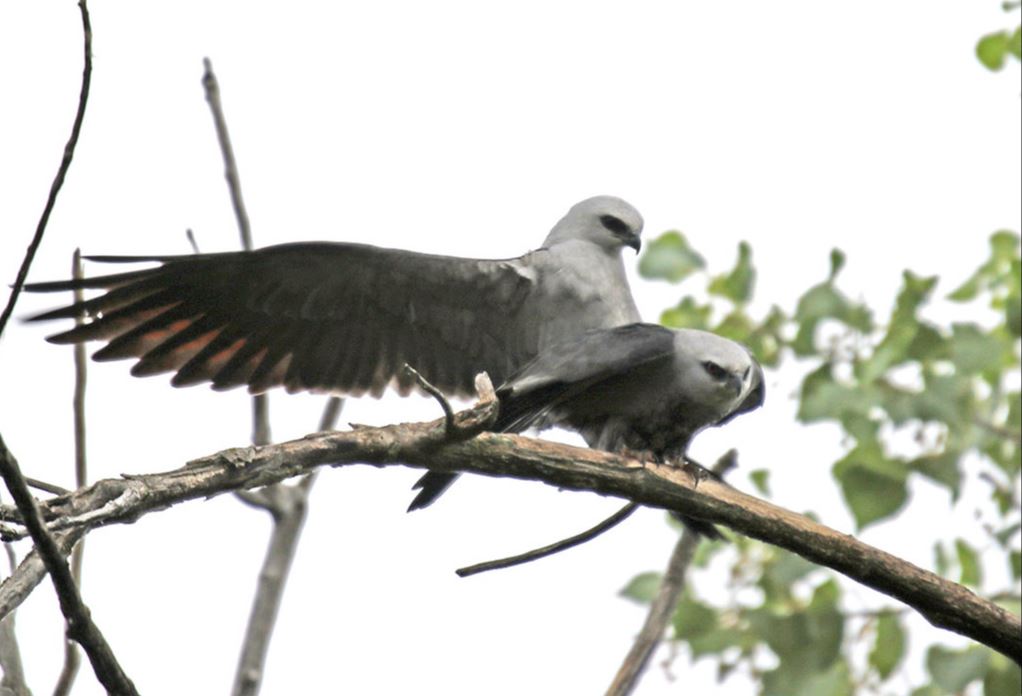BY LAURYN BECKER
Photo Courtesy
With the commotion caused last year on campus by the infamous Mississippi Kites, it should come as no surprise that the birds are preparing to make their grand return to campus again.
FHSU Assistant Professor of Biological Sciences, Medhavi Ambardar said these birds are drawn to the Hays and surrounding Kansas area due to the warm climate and the increase in insects this time of year.
“Mississippi Kites tend to be drawn to areas where they can nest and find food – mostly insects,” she said. “The Hays area has some trees, but not too many. It gets fairly warm in the summer, and there are plenty of insects. These characteristics seem to make the Hays area ‘just right’ for kite habitat.”
According to AllAboutBirds.org, the Mississippi Kites are birds that are small raptors sized between a crow and a goose. They gracefully glide through the air, but as the campus of Fort Hays learned last year, getting too close to these gliding birds puts them into attack mode, and they turn from gracefully gliding to dangerously dive-bombing on those who get too close.
“I think one thing to remember is that the Mississippi Kites are not being malicious. They simply have evolved to defend their babies against what they perceive as threat,” Ambardar said. “Unfortunately, some individuals are very bold and do not hesitate to dive-bomb people. While most kites are not that aggressive, we tend to notice the ones that are on the extreme end of the spectrum more, so it makes sense to be nervous when we start seeing these birds returning to the area.”
The Mississippi Kites’ nest cannot be moved unless the parent birds abandon the nest, and the birds are also federally protected under the Migratory Bird Treaty Act.
Due to these birds being drawn to campus and the community, last year, a section of trees by Forsyth Library and Malloy Hall was completely blocked off due to the dangerous swooping nature of these birds. This year, more preventative action is being taken as the campus has set out decoys to help prevent the birds from making FHSU their home again.
“In most cases, decoys don’t usually seem to deter bird nesting. I think it’s definitely worth a try, but, but for most birds, static decoys just become part of the background landscape to them once they get used to them,” Ambardar said.
For Fort Hays, the main priority is safety. Not only safety of students, faculty, and the community around campus but also for the Mississippi Kites. Ambardar lists some precautionary tips to avoid any dangerous interaction with these birds.
“What I typically do is avoid areas where it seems like they are nesting and wave my arms if I do see one that is dive-bombing. Some people also suggest walking with an open umbrella if you have to walk past a dive-bombing kite. I am trying to keep an eye on if and where kites are nesting on campus so I can monitor if they are being excessively aggressive,” Ambardar said.
Ambardar suggested that if FHSU notices the kites get excessively aggressive, the next step is to contact the Kansas Department of Wildlife and Parks to see what solutions they can develop to create a safe environment for everyone, including the birds.
“If we get a severely aggressive bird like last year, we might reach out to the Kansas Department of Wildlife and Parks to ask if they might have any solutions that will alleviate the attacks on people in the FHSU campus community,” she said.
According to Ambardar, there are a number of other migratory birds that call FHSU and Hays home. Members of the Fort Hays campus and the community alike can enjoy seeing all of these birds make their way to and around Hays.
“We have a lot of great birds on campus. The ones that people should look out for this summer include Baltimore Orioles, House Wrens, and Western Kingbirds,” she said. “In the wintertime, Dark-Eyed Juncos are very common on campus. And we have birds that can be seen year-round, like Northern Cardinals, American Robins, and White-breasted Nuthatches.”
Ambardar wants to emphasize the Mississippi Kites mean no harm. They migrate here to enjoy the warm summer and will migrate south again in the fall. It’s important always to maintain a safe distance between you and these birds to prevent any potential dive-bombing.
For more information on Mississippi Kites, visit https://www.allaboutbirds.org/guide/Mississippi_Kite/overview.

